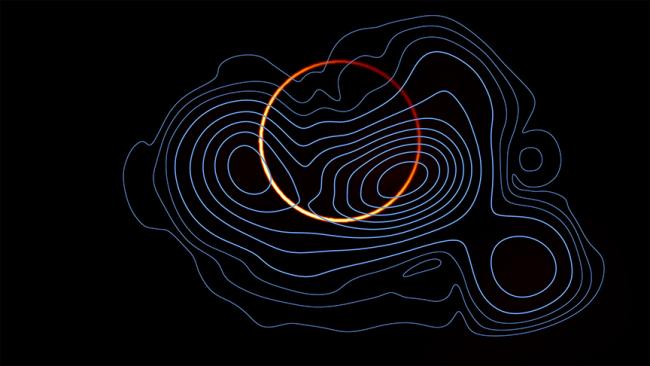Using new computational algorithms, scientists have measured a sharp ring of light predicted to originate from photons whipping around the back of a supermassive black hole.

Cambridge, MA – When scientists unveiled humanity’s historic first image of a black hole in 2019 — depicting a dark core encircled by a fiery aura of material falling toward it — they believed even richer imagery and insights were waiting to be teased out of the data.
Simulations predict that, obscured by that bright orange glow, there should exist a thin, bright ring of light created by photons flung around the back of the black hole by its intense gravity.
Now, a team of researchers has combined theoretical predictions and sophisticated imaging algorithms to “remaster” the original imagery of the supermassive black hole at the center of the galaxy M87*, first captured by the Event Horizon Telescope (EHT) in 2019. Their findings, published today in The Astrophysical Journal, are consistent with theoretical predictions and offer new ways to explore these mysterious objects, which are believed to reside at the hearts of most galaxies.
"The approach we took involved leveraging our theoretical understanding of how these black holes look to build a customized model for the EHT data," says Dominic Pesce, a study co-author based at the Center for Astrophysics | Harvard & Smithsonian and member of the EHT collaboration. "Our model decomposes the reconstructed image into the two pieces that we care most about, so that we can study both pieces individually rather than blended together."
The result was made possible because the EHT is a "computational instrument at its heart," says Avery Broderick, who led the study and holds the Delaney Family John Archibald Wheeler Chair at the Perimeter Institute. "It is as dependent on algorithms as it is upon steel. Cutting-edge algorithmic developments have allowed us to probe key features of the image while rendering the remainder in the EHT's native resolution."
To achieve this result, the team employed imaging software they developed called THEMIS, which enabled them to isolate the distinct ring features from the original observations of the M87* black hole — as well as reveal the telltale footprint of a powerful jet blasting outward from the black hole.
By essentially "peeling off" elements of the imagery, says co-author Hung-Yi Pu, an assistant professor at National Taiwan Normal University, "the environment around the black hole can then be clearly revealed."
Black holes were long considered unseeable until scientists coaxed them out of hiding with a globe-spanning network of telescopes known as the EHT. Using eight observatories on four continents, all pointed at the same spot in the sky and linked together with nanosecond timing, the EHT researchers observed two black holes in 2017.
The EHT collaboration first unveiled the supermassive black hole in M87* in 2019. Later in 2022, they revealed the comparatively small but tumultuous black hole at the heart of our own Milky Way galaxy, called Sagittarius A* (or Sgr A*).
Supermassive black holes occupy the centers of most galaxies, packing an incredible amount of mass and energy into a small space; the M87* black hole, for example, is 2 quadrillion (that's a two followed by 15 zeros) times more massive than Earth.
The M87* image that scientists unveiled in 2019 was a landmark discovery, but the researchers felt that they could still sharpen the image further and glean new insights. By applying their new software technique to the original 2017 data, the team was able to focus the data's constraining power on phenomena that theories and models predict are lurking beneath the surface.
The newly-developed technique is just now showing its promise on the existing EHT data from 2017.
"As we continue to add more telescopes and build out the next-generation EHT, the increased quality and quantity of data will allow us to place more definitive constraints on these signatures that we’re only now getting our first glimpses of," says co-author Paul Tiede, a CfA astrophysicist and EHT fellow at Harvard University's Black Hole Initiative.
###
About the Center for Astrophysics | Harvard & Smithsonian
The Center for Astrophysics | Harvard & Smithsonian is a collaboration between Harvard and the Smithsonian designed to ask—and ultimately answer—humanity's greatest unresolved questions about the nature of the universe. The Center for Astrophysics is headquartered in Cambridge, MA, with research facilities across the U.S. and around the world.
Media Contact:
Nadia Whitehead
Public Affairs Officer
Center for Astrophysics | Harvard & Smithsonian
nadia.whitehead@cfa.harvard.edu
617-721-7371
Related News
Runaway Stars Reveal Hidden Black Hole In Milky Way’s Nearest Neighbor
NASA's Hubble, Chandra Find Supermassive Black Hole Duo
Event Horizon Telescope Makes Highest-Resolution Black Hole Detections from Earth
CfA Celebrates 25 Years with the Chandra X-ray Observatory
CfA Astronomers Help Find Most Distant Galaxy Using James Webb Space Telescope
Astronomers Unveil Strong Magnetic Fields Spiraling at the Edge of Milky Way’s Central Black Hole
Black Hole Fashions Stellar Beads on a String
M87* One Year Later: Proof of a Persistent Black Hole Shadow
Unexpectedly Massive Black Holes Dominate Small Galaxies in the Distant Universe
Unveiling Black Hole Spins Using Polarized Radio Glasses
Projects
AstroAI
DASCH (Digital Access to a Sky Century @ Harvard)
For that reason, the DASCH (Digital Access to a Sky Century @ Harvard) team are working to digitize the plates for digital storage and analysis. The process can also lead to new discoveries in old images, particularly of events that change over time, such as variable stars, novas, or black hole flares.
GMACS
For Scientists
Sensing the Dynamic Universe
SDU Website